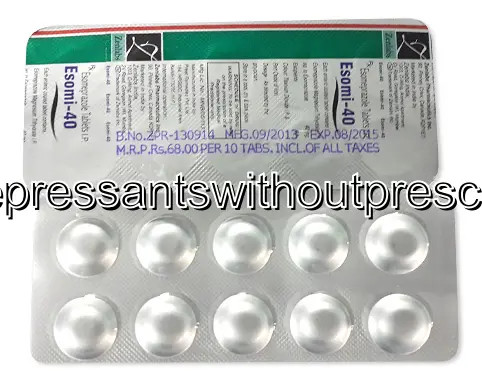| Package | Dosage | Price | Price per Dose | |
|---|---|---|---|---|
| Dosage: 20mg | ||||
| 360 pill | 20mg | NZD442.06 | NZD1.22 | |
| 270 pill | 20mg | NZD339.00 | NZD1.25 | |
| 180 pill | 20mg | NZD254.92 | NZD1.41 | |
| 120 pill | 20mg | NZD187.12 | NZD1.55 | |
| 90 pill | 20mg | NZD170.84 | NZD1.90 | |
| 60 pill | 20mg | NZD130.16 | NZD2.17 | |
| 30 pill | 20mg | NZD81.34 | NZD2.71 | |
| Dosage: 40mg | ||||
| 180 pill | 40mg | NZD327.09 | NZD1.82 | |
| 120 pill | 40mg | NZD230.51 | NZD1.93 | |
| 90 pill | 40mg | NZD208.81 | NZD2.33 | |
| 60 pill | 40mg | NZD151.86 | NZD2.52 | |
| 30 pill | 40mg | NZD94.90 | NZD3.17 | |

Esomeprazole Description
Overview of Esomeprazole
Esomeprazole is a commonly prescribed medication used to treat conditions related to excess stomach acid. It belongs to a class of drugs known as proton pump inhibitors (PPIs). These medications work by blocking the enzyme in the stomach lining responsible for producing acid. The result is a significant reduction in stomach acid, which helps alleviate symptoms and promotes healing of ulcers and other gastrointestinal issues.
Medical Uses and Effectiveness
Esomeprazole is primarily used to treat conditions such as gastroesophageal reflux disease (GERD), Zollinger-Ellison syndrome, and erosive esophagitis. Patients often find it effective in reducing the burning sensation associated with acid reflux and in preventing damage to the esophagus caused by stomach acids. Clinical studies have shown that Esomeprazole provides fast relief for many users, often within a day or two of starting treatment. Its ability to sustain acid suppression makes it a popular choice among healthcare providers.
How to Use Esomeprazole
This medication is generally available in capsule form and is typically taken once daily before a meal. The dosage may vary depending on the condition being treated, patient age, and response to therapy. It’s important to follow the directions provided by a healthcare professional or according to the instructions on the packaging. For best results, patients should not crush or chew the capsules, as this can interfere with the medication's effectiveness. Consistency in taking Esomeprazole daily is key to achieving optimal symptom relief.
Potential Benefits
Many users report significant improvement and relief from their symptoms after a few days of regular use. The medication not only relieves discomfort but also promotes healing of ulcers and reduces the risk of complications like bleeding. Additionally, because it suppresses acid production efficiently, Esomeprazole can be used as a preventative measure for those with chronic acid-related conditions. In some cases, long-term use can help manage complex reflux issues that do not respond to other treatments.
Possible Side Effects and Precautions
While many people tolerate Esomeprazole well, some may experience side effects. Common issues include headache, nausea, diarrhea, and abdominal pain. More rarely, users may encounter dizziness, dry mouth, or rash. Serious side effects are uncommon but can include vitamin B12 deficiency, osteoporosis-related fractures, or kidney problems with prolonged use. It is crucial to inform a healthcare provider if unusual symptoms occur or if any pre-existing health conditions exist. Patients should use Esomeprazole with caution in certain populations, such as those with liver disease or on other medications that may interact with PPIs.
Long-Term Use Considerations
Although Esomeprazole is highly effective for short-term relief, long-term use should be monitored carefully. Extended suppression of stomach acid can affect the absorption of certain nutrients and may increase the risk of bone fractures or infections like pneumonia. Healthcare providers often recommend periodic evaluation when using this medication for extended periods. Lifestyle adjustments, such as dietary changes and weight management, can complement medication therapy to enhance overall treatment outcomes.
